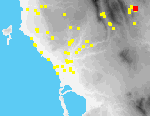 L04
Maryeli Velika (1)
L04
Maryeli Velika (1)
Tile: Byz, EMod-Mod
Site L4 is located on the NE slopes of a knoll overlooking the Velika River. The slopes are covered by weedy fields planted with olives, pears and figs; they are also used for pasturage. A very overgrown track crosses the site at its W edge; below it to the E, four terraces descend into the Velika valley.
At the SW edge of the site are the remains of walls and piles of stones from collapsed structures, including a long wall that runs downslope ca. 20 m. Perpendicular to it are terrace walls and long piles of stones (described below). The walls are constructed of roughly shaped limestone blocks, large waterworn cobbles, and fragments of tile.
Nearest the top of the knoll is a terrace wall ca. 40 m. L. Five meters downslope from it there is a pile of stones (15 m. L. x 3 m. W. x 2 m. H.).[112.19] Immediately N of the pile is a currant drying floor, recently used. Eight meters downslope is another pile of rubble (15 m. L. x 3 m. W. x 1 m. H.); 5 m. further is a 15 m.-long terrace or field wall.[112.18]
Artifacts associated with these stone walls were of post-Roman date. Roman pottery was found in a single field near the foot of the knoll, near the river. In 1995, a fragment of a millstone[093.19], probably a hand quern with part of its central hole preserved, was found built into the terrace wall at the top of the knoll; it is very similar to a millstone fragment observed in 1995 at Floka Panitsa (I22).
This is a relatively small site, consisting of four grid squares and three associated tracts. The collected material was characterized by a high percentage of tiles as opposed to vessel fragments. Material collected here can be divided into three discrete units: Roman, Byzantine, and Early Modern-Modern. Roman material was concentrated [in grid square 4251]. Later material was collected [from squares 4271, 4272 and 4281].